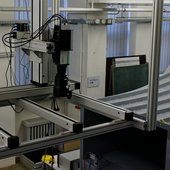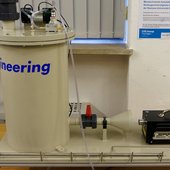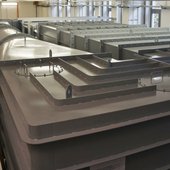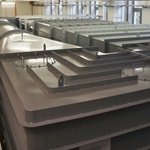
Low-speed wind tunnel
The low-speed wind tunnel opens up the possibility of directly validating the results of numerical simulations. This significantly supports and accelerates the development of numerical methods. The low-speed wind tunnel Göttingen type, is used for experimental flow analysis at wind speeds of 1 - 30 m / s with a very low degree of turbulence. This supports the experimental investigation of highly complex flow processes on building models and components or component models. The wind tunnel can be operated with both an open and a closed measuring section.
Technical specifications:
- Wind-speed: 1 – 30 m/s (infinitely variable)
- Degree of turbulence: 0,5% (closed measuring section), 0,8% (open measuring section)
- Measuring section (LxWxH): 2,50 x 1,30 x 0,80 m
- tracer particles compatible
2D Laser doppler anemometer for experimental flow analysis
The 2D Laser Doppler Anemometer (2D-LDA) is used for experimental flow analysis in the chair's low wind speed wind tunnel. With this optical measurement technology, physical variables, such as flow velocities and directions, can be detected in the flow around components in the wind tunnel in a punctual, non-invasive and high-frequency manner. This makes it possible to quantify flow parameters, which serve the scientifical validation of numerical methods as well as the better understanding of complex flow phenomena. The measuring system consists of the 2D-LDA, with two lasers of different wavelengths and an optic with a focal length of 800 mm, as well as a 3D-Traversierung, the automated admission is enabled over a distance of 1.00 x 1.00 x 1.00 m.
Technical specifications:
- 2D-LDA (2D FlowExplorer with ray expansion)
- Manufacturer: Dantec Dynamics
- Wave-lengths: 660 nm/ 785 nm
- Laser-power: 150 mm
- Focal length LDA optics: 800 mm
- 3D traversal 1010 x 1010 x 1010 mm (Resolution: 0,00625 mm)
The project, which was funded by the State of Thuringia, was co-financed by European Union funds under the European Regional Development Fund (ERDF).
Smoke generator with smoke lance for flow visualization in experimental flow analysis
Flow processes in the wind tunnel can be visualized by introducing a suitable smoke. The flow processes dominated by convection and diffusion can be visualized. The visualization takes place by introducing the smoke as finely as possible into the flow using a special lance with nozzles and imaging it. If the smoke is introduced to the upper flow of solids, so that their flow around can be visualized, the boundary layer, separation phenomena, possibly a reapplication of the flow, forming eddies and the wake turbulence can be seen. The smoke generator consists of a smoke machine with expansion tank and a mobile smoke lance with interchangeable nozzles (in number and diameter).
Technical specifications:
- Smoke generator for flow visualization (NV 1250 x 450)
- Manufacturer: Westenberg Wind Tunnels
- Surge tank: 50 Liter
- Mobile smoke lance
- Remote controlled and smoke emission adjustable
- Replaceable smoke nozzles
The project, which was funded by the State of Thuringia, was co-financed by European Union funds under the European Regional Development Fund (ERDF).
Multi-Pressure Measurement System (MPMS) for the high-frequency measurement of pressure distributions on model surfaces in experimental flow analysis
For the investigation of the wind loads of structures, the acting pressures or forces are of particular importance. The pressure component effectively acting on the surface is temporally variable, both spatially and as a result of transient processes. Integral force sizes do not allow a detailed insight into the pressure distribution and thus the underlying properties of the flow. Thus, pressure distributions are e.g. essentially dependent on the nature of the boundary layer. The Multi Pressure Measurement System enables the detection of distributed surface pressures at multiple discrete locations. The measuring system consists of 32 measuring points which can be integrated into the structure and a pressure scanner module.
Technical specifications:
- Multi Pressure Measurement System
- Make: DMT (PSI DTC Initium)
- Measuring points can be integrated
- Number of measuring points: 32
- Measuring frequency: up to 650 Hz
The project, which was funded by the State of Thuringia, was co-financed by European Union funds under the European Regional Development Fund (ERDF).
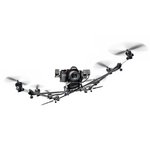
UAS equipment
The chair has a powerful fleet of professional aircraft systems of the type Intel Falcon 8, which are used for condition assessment of structures. The extremely wind-stable flying systems, equipped with high-quality camera technology, allow a flexible, secure and fast data acquisition even at higher wind speeds and within a short distance to the building. The high-resolution image data can be used for various applications in the context of condition assessment of buildings.
Technical specifications:
- Flight systems type Intel Falcon 8
- Extremely wind stable flight system
- Autopilot AscTec Trinity
- Flexible payload concept for the use of various payloads360° field of view of the camera
- GPS and altitude-controlled flight mode for outdoor and indoor use
- Automated data generation of structures using GPS-based navigation
Payloads:
- Sony Alpha 7R (System camera with 35 mm lens, 36 x 24 mm full-format sensor, 36 MP)
- Sony Camcorder HDR-PJ810E (Full HD video camera, 24 MP, 12x optical zoom)
- Inspection payload Panasonic Lumix DMC-TZ71 + IR camera FLIR TAU 2 640
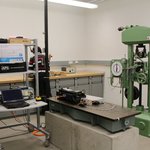
Structural health monitoring laboratory
In the "Laboratory for Structural Sensor Technology and Data Analysis", in short: "Sensor Laboratory", students and researchers in international, interdisciplinary teams can develop and practically test innovative concepts of sensor technology, modeling and data analysis. For this purpose, the sensor lab provides state-of-the-art components - such as programmable sensors and computer servers for modeling and data analysis - that can be used in research and teaching. In particular, projects related to core issues of digitization, such as smart sensor networks, smart structures, building information modeling, mobile/non-contact building monitoring, adaptive structures or sensor-based decision support, will be supported by the sensor lab.
The sensorics laboratory was jointly acquired by the professors of Computing in Civil Engineering, Simulation and Modelling of Structures as well as Steel Construction.
further Information
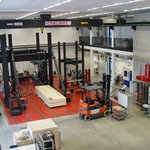
The Versuchstechnische Einrichtung (VTE) of the a Institute of Structural Engineering is a powerful partner to carry out experimental experiments that will enable the development and enhancement of analytical and numerical models. The VTE is closely linked to the chair by its director Ralf Kaufmann and its scientific director Prof. Guido Morgenthal.
further Information

